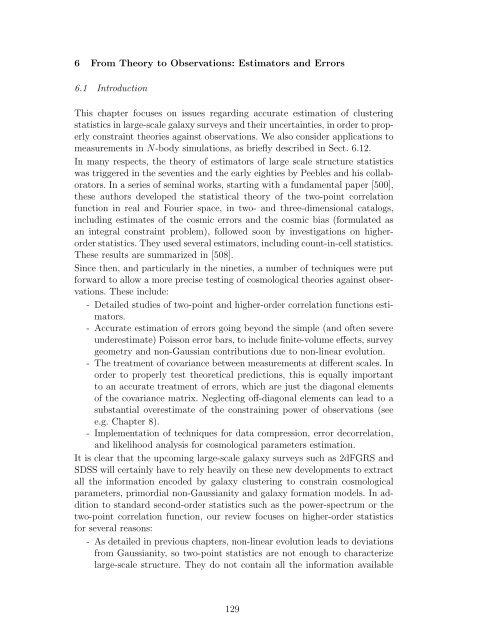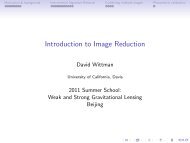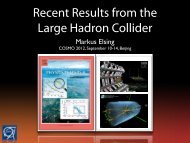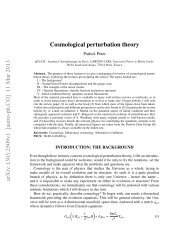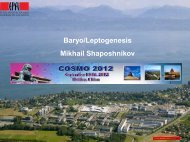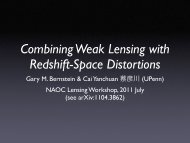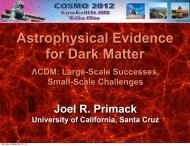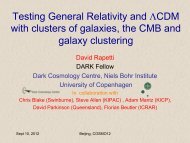Large-Scale Structure of the Universe and Cosmological ...
Large-Scale Structure of the Universe and Cosmological ...
Large-Scale Structure of the Universe and Cosmological ...
Create successful ePaper yourself
Turn your PDF publications into a flip-book with our unique Google optimized e-Paper software.
6 From Theory to Observations: Estimators <strong>and</strong> Errors<br />
6.1 Introduction<br />
This chapter focuses on issues regarding accurate estimation <strong>of</strong> clustering<br />
statistics in large-scale galaxy surveys <strong>and</strong> <strong>the</strong>ir uncertainties, in order to properly<br />
constraint <strong>the</strong>ories against observations. We also consider applications to<br />
measurements in N-body simulations, as briefly described in Sect. 6.12.<br />
In many respects, <strong>the</strong> <strong>the</strong>ory <strong>of</strong> estimators <strong>of</strong> large scale structure statistics<br />
was triggered in <strong>the</strong> seventies <strong>and</strong> <strong>the</strong> early eighties by Peebles <strong>and</strong> his collaborators.<br />
In a series <strong>of</strong> seminal works, starting with a fundamental paper [500],<br />
<strong>the</strong>se authors developed <strong>the</strong> statistical <strong>the</strong>ory <strong>of</strong> <strong>the</strong> two-point correlation<br />
function in real <strong>and</strong> Fourier space, in two- <strong>and</strong> three-dimensional catalogs,<br />
including estimates <strong>of</strong> <strong>the</strong> cosmic errors <strong>and</strong> <strong>the</strong> cosmic bias (formulated as<br />
an integral constraint problem), followed soon by investigations on higherorder<br />
statistics. They used several estimators, including count-in-cell statistics.<br />
These results are summarized in [508].<br />
Since <strong>the</strong>n, <strong>and</strong> particularly in <strong>the</strong> nineties, a number <strong>of</strong> techniques were put<br />
forward to allow a more precise testing <strong>of</strong> cosmological <strong>the</strong>ories against observations.<br />
These include:<br />
- Detailed studies <strong>of</strong> two-point <strong>and</strong> higher-order correlation functions estimators.<br />
- Accurate estimation <strong>of</strong> errors going beyond <strong>the</strong> simple (<strong>and</strong> <strong>of</strong>ten severe<br />
underestimate) Poisson error bars, to include finite-volume effects, survey<br />
geometry <strong>and</strong> non-Gaussian contributions due to non-linear evolution.<br />
- The treatment <strong>of</strong> covariance between measurements at different scales. In<br />
order to properly test <strong>the</strong>oretical predictions, this is equally important<br />
to an accurate treatment <strong>of</strong> errors, which are just <strong>the</strong> diagonal elements<br />
<strong>of</strong> <strong>the</strong> covariance matrix. Neglecting <strong>of</strong>f-diagonal elements can lead to a<br />
substantial overestimate <strong>of</strong> <strong>the</strong> constraining power <strong>of</strong> observations (see<br />
e.g. Chapter 8).<br />
- Implementation <strong>of</strong> techniques for data compression, error decorrelation,<br />
<strong>and</strong> likelihood analysis for cosmological parameters estimation.<br />
It is clear that <strong>the</strong> upcoming large-scale galaxy surveys such as 2dFGRS <strong>and</strong><br />
SDSS will certainly have to rely heavily on <strong>the</strong>se new developments to extract<br />
all <strong>the</strong> information encoded by galaxy clustering to constrain cosmological<br />
parameters, primordial non-Gaussianity <strong>and</strong> galaxy formation models. In addition<br />
to st<strong>and</strong>ard second-order statistics such as <strong>the</strong> power-spectrum or <strong>the</strong><br />
two-point correlation function, our review focuses on higher-order statistics<br />
for several reasons:<br />
- As detailed in previous chapters, non-linear evolution leads to deviations<br />
from Gaussianity, so two-point statistics are not enough to characterize<br />
large-scale structure. They do not contain all <strong>the</strong> information available<br />
129


